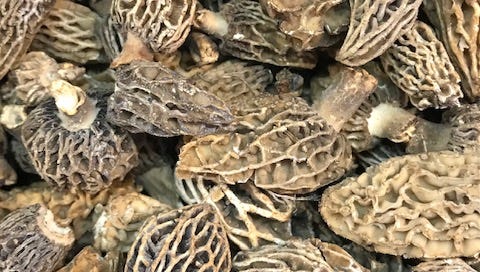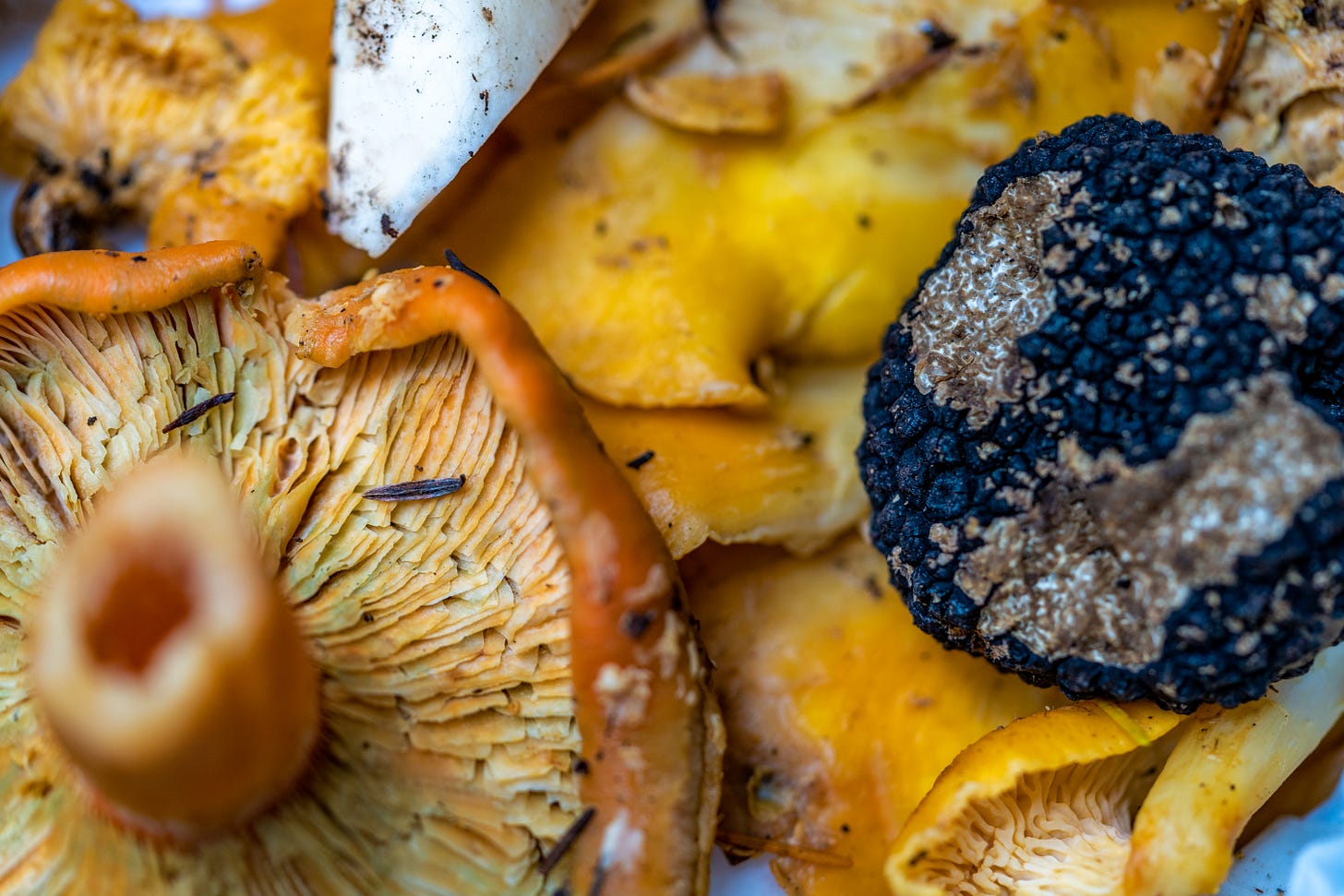NAPA VALLEY, Calif. — The UC Master Gardener’s February meeting was enlivened by Gordon A. Walker, otherwise known as the “fungus guy.” Walker has a doctorate in biochemistry and molecular biology from UC Davis and worked in the wine industry for a time. I have noticed that many people who are interested in mushrooms have a background in winemaking or bread baking. I think it’s related to the fermentation.

Walker’s avocation, however, is learning all about wild mushrooms, preferably in their natural habitat, and teaching people about them. He lives in Napa and tries to take a walk in the woods every day.
Walker finds fungi endlessly enthralling, and if you follow him on social media, you will, too. His website is called “Fascinated by Fungi,” and he has a podcast and YouTube channel by that name as well. I spent several hours exploring them and I learned a lot. You can also sign up for one of his guided mushroom walks, or keep an eye out for his mushroom-themed dinners at local restaurants.
My attraction to wild mushrooms is, first, their beauty, and second, their edibility. I have friends in Santa Cruz who are mushroom foragers, and it seems that every year during mushroom season some hapless daredevil ends up with liver damage from a misidentified tidbit that turned out to be poisonous. The way to avoid this fate is to learn how to recognize the evildoers.
Walker, in his lecture to the Master Gardeners, recommended the book “Mushrooms of the Redwood Coast” by Noah Siegel and Christian Schwarz. The book is packed with color pictures, information about habitat and—very important—guidance on edibility.
For example, the honey mushroom (Armillaria mellea) found in Napa County growing on oaks and madrone is quite tasty, but you should only eat the caps of young specimens. The stipes (stems) are tough. The caps should be thoroughly cooked to avoid an upset stomach.
From one of Walker’s podcasts, I learned about the iNaturalist app, sponsored by the California Academy of Sciences. The app is free and, once installed on your phone, it allows you to connect with amateur and professional naturalists who can help you identify wild mushrooms you find. Send in your photographs and you will get replies.
Walker offered tips for photographing mushrooms for identification purposes. Get down and photograph the fungi at their level, including the stems and gills. Don’t forget to take shots of the habitat where you found them; that’s helpful for identification.
Walker told the Master Gardeners about the “top-tier wild mushrooms:” chanterelle (Cantharellus), king boletus/porcini (Boletus edulis), hedgehog (Hydnum repandum), black trumpet (Craterellus), lion’s mane (Hericium erinaceus), chicken of the woods (Laetiporous sulphureus), cauliflower (Sparissus) and black and blonde morel (Morchello).
He also showed us images of poisonous mushrooms. To me, jack-o’-lantern (Omphalotus olearius) looked uncomfortably similar to chicken of the woods, and death cap (A. phalloides) to hedgehog. This is why one should pay attention to variations in the rim of the cap, the gills and the habitat.
On the other hand, the familiar fly agaric (Amanita muscaria) was its readily recognizable self: red with white dots, just like the in the old fairy-tale illustrations. This colorful fungus is quite cosmopolitan; it is found all over the world. I have seen it under oak and eucalyptus trees in Napa. Siegel and Schwarz describe it as “extremely toxic and mind altering.”
It isn’t hard to grow wild mushrooms at home. The Sierra Club recommends oyster mushrooms (Pleurotus ostreatus) as the easiest to grow. Oyster mushrooms are considered saprophytic fungi as they grow on decaying oak and alder. The word “saprophytic” comes from the Greek sapros (which means putrid) and phyton (which means plant). It is an attractive mushroom that grows in layers, shaped like an oyster shell or fan.
To grow mushrooms at home, you need to buy a mushroom block—mushroom spawn pressed into a block with substrate (growing medium). Keep it out of direct light and in a humid environment, such as near a kitchen sink or in a plastic bag with holes in it, and wait.
Mushroom spawn is a mix of mycelium, an active mushroom culture that looks like white threads. Oyster mushrooms are fast growing, and you can often start harvesting after a week. You can generally get two crops from a single mushroom block, and sometimes as many as five. In the springtime you can take the block outside.
You can also create a mushroom patch in your yard, roughing up the dirt under a tree or under tall vegetables, adding clean hardwood chips and then adding spawn. Keep the area damp.
Or you can buy mushroom spawn, put it in a clean plastic 5-gallon bucket with holes in it and layer in more substrate. (Wood chips and cut-up cardboard work well.) Keep it damp with a spray bottle, and you will have mushrooms.
My compost pile is loaded with mycelium. If I stopped turning it, I would have mushrooms.
The Sierra Club suggests purchasing your mushroom-growing supplies locally. Some unscrupulous mushroom dealers are irresponsible about contamination or may sell you spawn for supermarket mushrooms. Check with local nurseries. The Napa Farmers Market also has a mushroom purveyor, Far West Fungi, who sells mushroom growing supplies.
We still have so much to learn about the world of fungi. A walk in the woods is a good place to start.
Workshop: Join UC Master Gardeners of Napa County for “Spring into Summer Vegetable Garden” on Saturday, March 17, from 2 p.m. to 4 p.m., at Yountville Community Center, 6516 Washington Street, Yountville. Plan your vegetable growing for the warm weather ahead. Topics include soil prep, fertilizing, managing pests, irrigation and planting schedules. This is a hands-on workshop and registration is required. To register, contact the Yountville Parks and Recreation Department.
Workshop: Join UC Master Gardeners of Napa County for “Home Vineyards: Important Information for a Successful 2024,” on Saturday, March 30, from 9 a.m. to 12:30 p.m.
Learn the latest about irrigation and treating viruses and mildew. Get up to date on climate change, soil health and structure, increasing soil organic matter and what happens in the vineyard post pruning. Workshop will be held in a barn at a private home vineyard near Napa. Attendance is free but you must register to get the address and additional details. https://surveys.ucanr.edu/survey.cfm?surveynumber=42128
Help Desk: The Master Gardener Help Desk is available to answer your garden questions on Mondays and Fridays from 10 a.m. until 1 p.m. at the University of California Cooperative Extension Office, 1710 Soscol Avenue, Suite 4, Napa. Or send your questions to mastergardeners@countyofnapa.org. Include your name, address, phone number and a brief description.
References: “How to Grow Mushrooms at Home—A Beginner’s Guide,” by Jacqueline Kehoe. Sierra Club, May 23, 2023.
“Mushrooms of the Redwood Coast—A Comprehensive Guide to the Fungi of Coastal Northern California,” by Noah Siegel and Christian Schwarz, Ten Speed Press, 2016.
If today's story captured your interest, explore these related articles:
Napa’s convergent lady beetles: a Master Gardener’s discovery and insights
Moths and butterflies: Understanding their role and diversity in our gardens
Cindy Watter is a UC Master Gardener of Napa County.






Mushrooms will be the saviors of the earth. You can eat them, make things with them, as in packaging, and even cleanup land based oil spills. Totally clean up. Within weeks. I expect to see clothing and homes made of mycelium in the future. I don’t forage to eat, but I do forage to photograph. They are endlessly fascinating. I was heartbroken when, after locking us out of Las Posadas, they cut down old growth trees and bulldozed the stumps. In the interest of “forest management” an entire mycelium ecosystem was destroyed. Don’t misunderstand me, the young trees need to be thinned, but to bulldoze a healthy mycelium ecosystem is a crime.
Just found an article, from the BBC no less, about mycelium and how it is currently being used. Had no idea it was being used to clean up the 2017 fires. And they are indeed using it to build houses.
“CoRenewal works to develop and implement sustainable solutions to restore damaged ecosystems, from post-wildfire regeneration, to cleaning up oil spills, to reducing toxins in the built environment. The organisation began with the mission of cleaning crude oil pollution in the Ecuadorian Amazon using oyster mushrooms, which are well known for their ability to break down petroleum and hydrocarbons. They shifted their efforts to post-wildfire cleanup in the wake of Northern California wildfires in 2017, applying fungal materials to prevent toxic ash runoff from entering fresh waterways and regenerate ecosystems damaged by fire. Currently they're testing the effectiveness of this treatment in five wildfire hotspots along the US' West Coast and expect to have results by early 2024.”
https://apple.news/AKKi5MVjlQTS9uop2cHjJaw